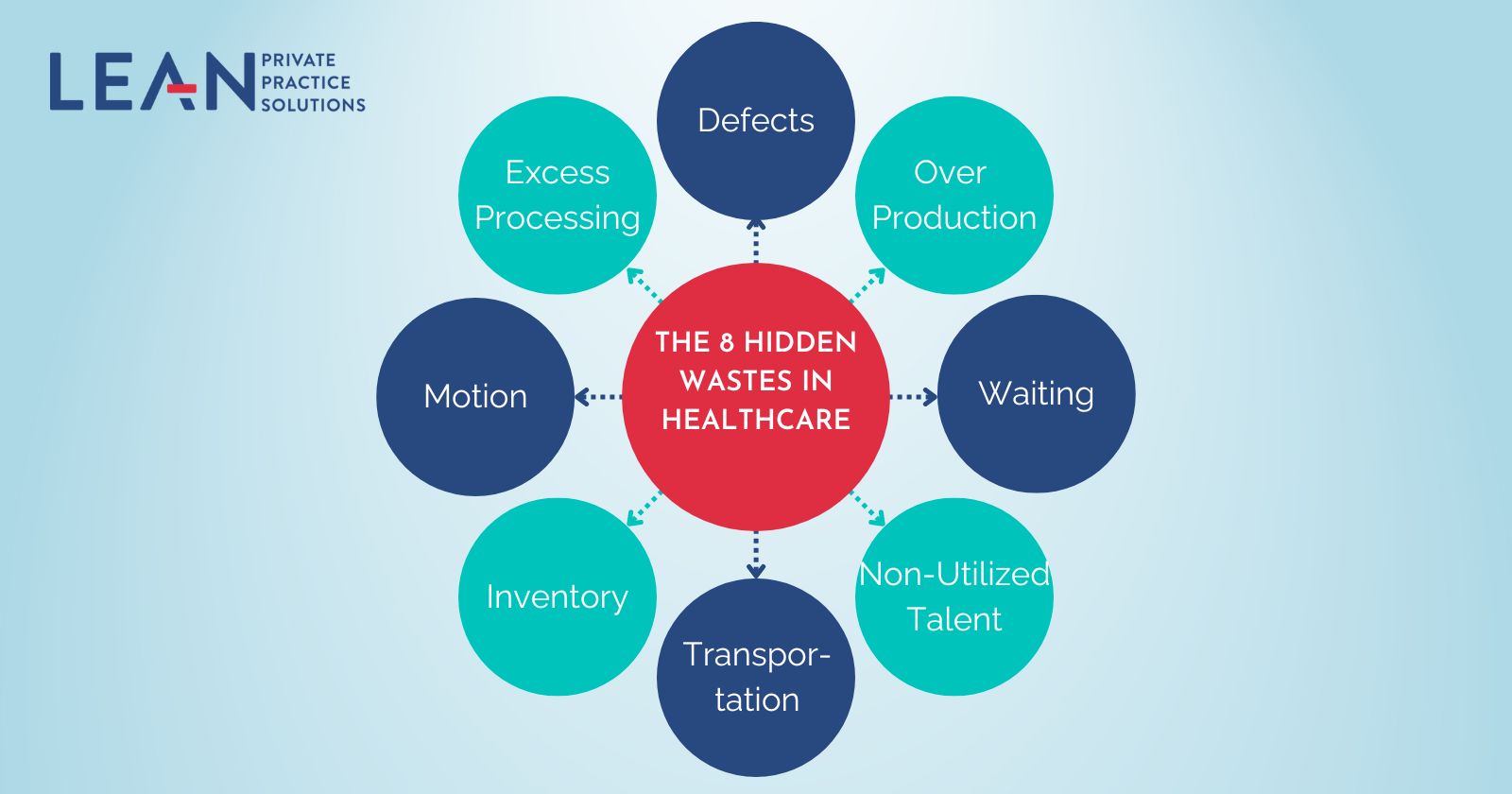8 KINDS OF WASTE
We’ve talked earlier about how Lean process aims to deliver perfect value with zero waste.
Lean principles identify 8 kinds of waste- and the goal is to reduce them by following the lean way.
These 8 wastes are….
![]() Defects
Defects
![]() Overprodcution
Overprodcution
![]() Waiting time
Waiting time
![]() Transportation
Transportation
![]() Excess Inventory
Excess Inventory
![]() Wasted Motion
Wasted Motion
![]() OverProcessing
OverProcessing
![]() Unused talent
Unused talent
By the sound of them, it may seem relevant only for manufacturing, but you’d be surprised that we have the same inefficiencies in our systems, hiding in plain sight.
Let’s talk a little bit about them:
Waste #1: Over-processing
Overprocessing refers to having extra or unnecessary steps in processes.
Some common examples:
*asking pts to fill out more forms than needed,
*different forms that ask patients the same information (been there, not fun as a patient, either!),
*double entry of data due to disjointed systems…. maybe because the EMR doesnt talk to the Practice management system, needing the same data to be manually put into both systems.
*unnecessary signatures on documents.
Sounds familiar, doesn’t it??
Waste #2: Overproduction
As the name suggests, overproducing means making more of something than is required, which subsequently gets wasted. (Duh, as my teen would say).
Examples include:
*making too many copies of a document which you then declare obsolete because you switched to a different form
*making copies as a matter of routine w/o checking if there is need for it, which then ends up right in the recycle/shredding bin!
Waste #3: Transportation
Transportation waste may not be a big deal in a small office but can become an issue in a larger setup.
Transportation costs time and money and adds no value.
*How far do patients have to go from the parking lot to the waiting room and then to the exam room?
*Or do patients have to walk to different parts of the building for ancillary services like labs or X-rays??
Waste #4: Excess inventory
Excess waste both ties up capital and takes up real-estate for storage.
*excess inventory of supplies or medication- some of which may then expire or be declared obsolete because you switched to a different product/equipment/medication,
*We can even think of outdated technology as excess inventory. For example, an old-school phone/ fax/ internet system: that requires you to have dedicated IT services to maintain and troubleshoot. As opposed to an up-to-date tech stack that does not need these additional expenses because all the software comes with built-in security. No IT services required.
*A startup practice leasing or buying a big space- and most of the space sitting empty most of the time
*An overstaffed office
And as you know well, office space and staff are the most most expensive line items on a practice’s balance sheet. We can ill-afford to be wasteful, particularly in these areas.

Waste #5: Wasted motion
In factories, in the assembly line, they found that workers reaching or bending repeatedly to perform their tasks resulted in injury and created inefficiency.
You might be surprised how often wasted motion occurs in the office setting:
*Mouse clicks on EHR, which all of us are familiar with (I can almost hear you groan!)
*Exam rooms far apart and lots of walking to and fro for everyone involved.
*Remember the waste of transportation: when patients have to walk long distances from the waiting room to the exam room? It results also in wasted motion for your staff, who walks the patients down to the room.
And this is with every patient, several times a day- seriously taking away from their productivity!
*Supplies stored too high or too low in non-ergonomic positions.
*Maybe the supply closet is far away from the procedure room. This means your staff has to constantly trek to gather supplies every time a procedure is done.
*Maybe files are stored in the file room. And everyone alaways has to walk back and forth to get the files/paperwork they need for their jobs.
*Maybe the copier/scanner is in the office manager’s office- but your front desk is the person who uses that machine most commonly- then it may be time to rehome that machine.
*Do the people who do similar things or parts of the same process work together in close proximity?
For example, the physician and her MA.
Maybe the MA works at the nurses station and the doctor is in an office in the next hallway. It was designed so that doctor could do her work away from the din.
However, as a result, whenever they need to communicate with each other, one has to walk down or call the other- thereby constantly interrupting the other’s workflow.
Waste #6: Waiting/idle time
Our practices are, unfortunately, rife w examples of waiting time. Just ask a patient!
*patients waiting weeks and months for appointments
*patients in the waiting room, waiting to be called back to be seen
*staff waiting for someone else to finish something- so THEY can get to their turn in the process.
For example, an MA waiting for the front desk to complete check-in so she can call the patient back to room them. Or the check-out person waiting for the visit to be complete so she can do her job.
*Idle equipment: all of the time any equipment is lying unused, it contributes to waste.
For instance, your big fancy laser machine that is costing you an arm and leg- and does not have the volume you anticipated (or rather, what the sales rep anticipated FOR you!!!!)
Or, the phlebotomist you hired before you had enough of a patient volume.
Waste #7: Errors/Defects
Defects is the word they generally use in manufacturing. In medicine, we use the word errors.
In the office setting:
*Errors in medication refills or ordering labwork. Missed allergies. Medication interactions
*Broken or misplaced equipment or supplies, leading to procedures delayed or worse, have bad outcomes.
*Billing errors, resulting in what could amount to massive losses. These could be a high % of Accounts Receivables more than 60/90days, with no one following through on denials.
*Standard Operating Process (SOPs) not being followed. Or, worse still, SOPs not in place! For example, Eligibility Verifications not done routinely because there is no system in place: when is it supposed to be done? Who is supposed to do it? None of it.
As a downstream effect, if Eligibility Verfications are not done, patient responsibility is not known ahead of time and then not collected at visit. Once the patient leaves your office, it is INCREDIBLY hard to collect from them.
Waste #8: Unused talent
This is probably the most egregious waste of all.
Nothing leads to progress more than innovation born of human ingenuity.
And ingenuity takes time to cultivate.
If employees are mired in activities that do not add to patient benefit- that is a colossal waste.
That talent and creativity could be used either for personal development or benefit to the organization.
Disengaged employees work robotically, just doing what they are told.
Engaged employees actively participate in improving processes.
Truth is, people in the trenches are the ones most capable of identifying problems and coming up with solutions.
This goes all the way to the top….
How often do we talk of admin folks not knowing what the heck they’re talking about because they’ve never been involved in patient care.
Examples of unused talent…
*Physicians spending precious time on onerous charting.
*Physicians and staff bogged down with prior authorizations and peer review conferences for what are clearly, medically necessary tests or treatments.
*Billers spending hours on the phone with insurers, trying to fight unjust claim denials.
In essence, when time and effort are utilized to do work that neither adds to the quality of care that patients receive nor their health outcomes, that work is essentially waste.
And we should try our best to minimize them by implementing lean practice.




